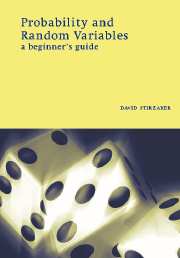1 - Introduction
Published online by Cambridge University Press: 05 June 2012
Summary
I shot an arrow into the air
It fell to earth, I knew not where.
H.W. LongfellowO! many a shaft at random sent
Finds mark the archer little meant.
W. ScottPREVIEW
This chapter introduces probability as a measure of likelihood, which can be placed on a numerical scale running from 0 to 1. Examples are given to show the range and scope of problems that need probability to describe them. We examine some simple interpretations of probability that are important in its development, and we briefly show how the well-known principles of mathematical modelling enable us to progress. Note that in this chapter exercises and problems are chosen to motivate interest and discussion; they are therefore non-technical, and mathematical answers are not expected.
Prerequisites. This chapter contains next to no mathematics, so there are no prerequisites. Impatient readers keen to get to an equation could proceed directly to chapter 2.
PROBABILITY
We all know what light is, but it is not easy to tell what it is.
Samuel JohnsonFrom the moment we first roll a die in a children's board game, or pick a card (any card), we start to learn what probability is. But even as adults, it is not easy to tell what it is, in the general way.
- Type
- Chapter
- Information
- Probability and Random VariablesA Beginner's Guide, pp. 1 - 28Publisher: Cambridge University PressPrint publication year: 1999



